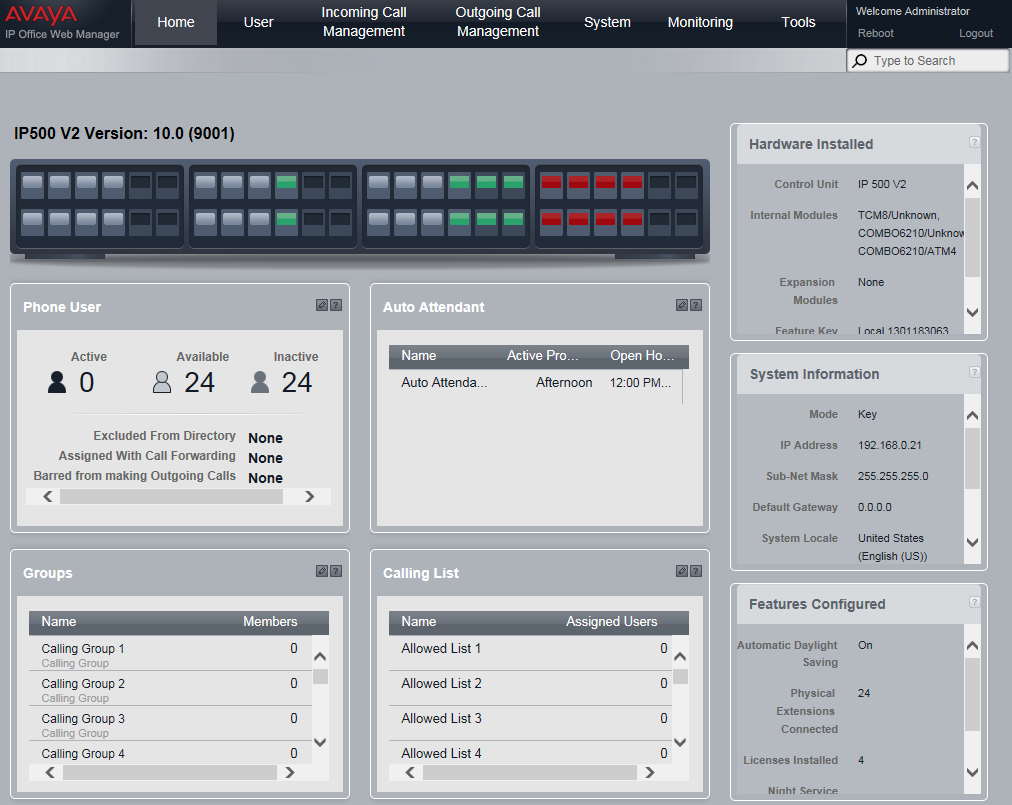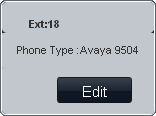The home page for Basic Edition Web Manager provides a quick overview of the system and the current system status.

The Dashboard
The dashboard is a representation of the IP Office system, showing the extension and trunks ports. If you hover the cursor over a particular port, a summary windows is shown. For example, for an extension port, the name and extension number of the extension user are shown. Clicking the Edit button in the summary will access the appropriate user or trunk settings menu for that port.


Phone User
This panel shows a summary of the installed user extensions. The ![]() edit icon can be used to access the Users menu.
edit icon can be used to access the Users menu.
Auto Attendant
This panel gives a summary of the auto attendant services (up to 9) currently configured. For each configured auto attendant, the current service being provided by the auto attendant is shown and the hours for that service. Each auto attendant can be configured with different greeting and options for morning, afternoon, evening and out of hours periods.
The ![]() edit icon can be used to access the Auto Attendants menu.
edit icon can be used to access the Auto Attendants menu.
Groups
This panel shows a summary of which hunt groups have been configured. The ![]() edit icon can be used to access the Groups menu.
edit icon can be used to access the Groups menu.
•Calling Group
This type of group can be set as the Coverage Destination of a trunk or trunk channel. It can be also the destination of calls routed using DID call mapping or call-by-call settings. Calling Group 1 is also used by the Simultaneous Page function (*70).
•Hunt Group
This type of group can be set as the Coverage Destination of a trunk or trunk channel. It can also be the destination of calls routed using DID call mapping or call-by-call settings.
•Night Service Group
When the system is put into night service, this group overrides the Coverage Destination of all trunks.
•Operator Group
This option is only available for systems with their Mode set to PBX. By default the group contains the first extension on the system. For PRI and BRI trunks, it is fixed incoming destination for calls unless DID Mapping is applied to the call. It can also be selected as the destination for incoming SIP calls.
•Pickup Group
Users can be pickup calls currently alerting any member of a pickup group. They do not need to be a member of the group.
Calling List
This panel shows a summary of the lists that are used to control which numbers users can dial when making outgoing calls. The ![]() edit icon can be used to access the List Management menu to edit the settings.
edit icon can be used to access the List Management menu to edit the settings.
•Allowed List
Allowed lists are used to enter numbers or types of numbers that users associated with the list can dial even if they are restricted from dialing other numbers. Up to 8 such lists, each containing 10 numbers, can be configured.
•Disallowed List
Disallowed lists are used to enter numbers or types of numbers that users associated with the list cannot dial. Up to 10 such lists can be configured. Up to 8 such lists, each containing 10 numbers, can be configured.
•Emergency Number List
This list is used to enter numbers that all users can dial at any time regardless of any other settings that might restrict them from dialing numbers for outgoing calls. Up to 10 numbers can be configured in this list.
•Account Codes
Up to 99 account codes can be entered. In addition selected users can be configured to have to enter an account code whenever they make an outgoing external call.
